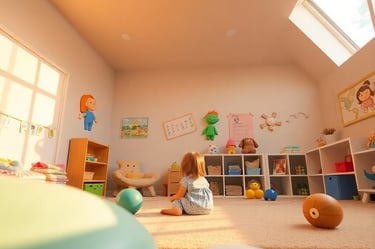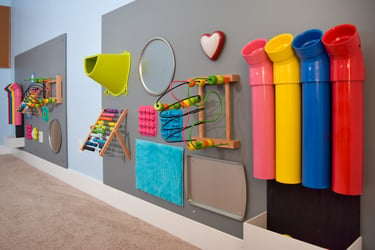Autism Sensory Toys: Reducing Clutter for Military Families on the Move
A thoughtful approach to toy selection and storage can provide both the sensory support autistic children need and a clutter-free living space that eases transitions between homes. Sensory toys help autistic children regulate emotions, develop motor skills, and engage with their environment in a comfortable way.
W. Love
2/13/20252 min read
For military families, frequent relocations are a way of life. Packing up and moving every few years—or even more often—makes organization and decluttering a necessity. For families with autistic children, managing an array of sensory toys while maintaining a minimalist home can be a challenge. However, a thoughtful approach to toy selection and storage can provide both the sensory support autistic children need and a clutter-free living space that eases transitions between homes.
Sensory toys help autistic children regulate emotions, develop motor skills, and engage with their environment in a comfortable way. These toys often include fidget items, weighted blankets, textured objects, and interactive lights or sounds. While these tools are essential, they can easily accumulate and create clutter, making organization crucial—especially for military families constantly on the move.
Minimalist Approach to Sensory Toys
Minimalism doesn’t mean depriving a child of the tools they need; instead, it’s about being intentional with what’s kept and how it’s used. A minimalist approach to autism sensory toys involves selecting multifunctional, durable, and portable items that can provide the necessary sensory benefits without overwhelming the living space.
Here are some ways to reduce clutter while maintaining an autism-friendly environment, especially if you have multiple children:
1. Choose Multi-Purpose Toys
Invest in sensory toys that serve multiple functions. For example:
A weighted lap pad that doubles as a pillow
A fidget cube with various textures, buttons, and movements
A pop-it mat that can be used for both stress relief and learning activities
A sensory swing that can be easily folded and reinstalled in a new home
By choosing versatile items, you can minimize the number of toys while still meeting sensory needs.
2. Rotate Toys to Reduce Overload
Instead of keeping all sensory toys out at once, create a rotation system. Store some toys in labeled bins and swap them out every few weeks. This keeps playtime fresh while reducing clutter. It also makes packing and moving easier since only a portion of the toys will need to be immediately accessible.
3. Prioritize Portable and Compact Options
For families on the move, portability is key. Look for sensory toys that are lightweight, foldable, or easily transportable. Consider:
Foldable noise-canceling headphones
Compact fidget keychains
Inflatable sensory balls instead of bulky foam pieces
Keeping a travel-friendly sensory kit can also be helpful for long road trips or adjusting to new environments.
4. Use Smart Storage Solutions
Storage bins with clear labels and compact shelving units can help keep sensory toys organized. Under-bed storage, hanging organizers, and multi-compartment bins allow for easy access without creating mess. When moving, using stackable bins keeps everything neat and transport-ready.
5. Involve Your Child in the Process
Helping your child choose which toys to keep, donate, or rotate fosters independence and emotional regulation. By making decluttering a routine, it becomes easier to manage transitions to new homes without overwhelming changes.
Minimalist design and sensory-friendly spaces are not mutually exclusive. Military families can create a balance between providing necessary sensory tools for their autistic children and maintaining an organized, clutter-free home. By prioritizing multi-use, portable, and well-organized sensory toys, families can reduce moving stress and create a comforting environment, no matter where they go.






